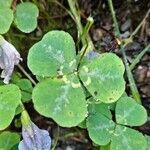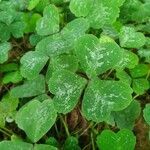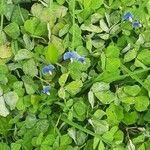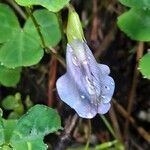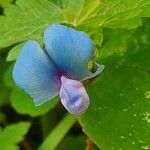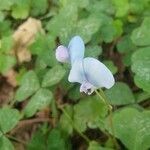Stems prostrate to ascending, 10-20 cm, tubers lacking. Stipules 4-5 mm, membranous, entire, free; petiole 8-15 cm, slender, pubescent; petiolule less than 1 mm; leaflets 8-20 × 10-20 mm, lateral veins 4 or 5 pairs, base narrowly cuneate, margins entire or minutely serrate. Inflorescence umbellate; peduncle longer than or equal to petiole; pedicels 5-10 mm; flowers 1-3. Calyx 6-9 mm, pubescent. Corolla blue or purple, rarely white or pink, ca. 20 mm; standard 1.4-2 cm, claw 3-5 mm; wings falcate-oblong, auricle 2-4 mm; keel abruptly inflexed, acute. Legume linear-ovate, 20-25 × 3-4 mm. Seeds 8-12, ca. 2 × 1 mm. Fl. and fr. Apr-Nov.
A creeping herb. It forms a ground cover. It grows 10 cm high and spreads 30 cm wide. It loses its leaves during the year. The leaflets are closely flattened. They are clover-like and divided into 3 leaflets. The leaves are 12 mm long. They are hairy underneath. The flowers are deep blue and like pea flowers. They are 12-25 mm wide. They occur singly or in pairs. The pods are 2.5 cm long.
